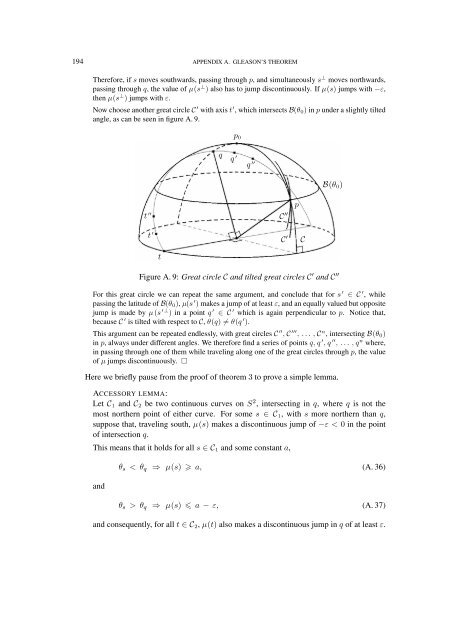FOUNDATIONS OF QUANTUM MECHANICS
FOUNDATIONS OF QUANTUM MECHANICS
FOUNDATIONS OF QUANTUM MECHANICS
Create successful ePaper yourself
Turn your PDF publications into a flip-book with our unique Google optimized e-Paper software.
194 APPENDIX A. GLEASON’S THEOREM<br />
Therefore, if s moves southwards, passing through p, and simultaneously s ⊥ moves northwards,<br />
passing through q, the value of µ(s ⊥ ) also has to jump discontinuously. If µ(s) jumps with −ε,<br />
then µ(s ⊥ ) jumps with ε.<br />
Now choose another great circle C ′ with axis t ′ , which intersects B(θ 0 ) in p under a slightly tilted<br />
angle, as can be seen in figure A. 9.<br />
p 0<br />
q<br />
q ′ q ′′ B(θ 0 )<br />
t ′′<br />
C ′′<br />
p<br />
t ′<br />
C ′<br />
C<br />
t<br />
Figure A. 9: Great circle C and tilted great circles C ′ and C ′′<br />
For this great circle we can repeat the same argument, and conclude that for s ′ ∈ C ′ , while<br />
passing the latitude of B(θ 0 ), µ(s ′ ) makes a jump of at least ε, and an equally valued but opposite<br />
jump is made by µ (s ′⊥ ) in a point q ′ ∈ C ′ which is again perpendicular to p. Notice that,<br />
because C ′ is tilted with respect to C, θ(q) ≠ θ(q ′ ).<br />
This argument can be repeated endlessly, with great circles C ′′ , C ′′′ , . . . , C n , intersecting B(θ 0 )<br />
in p, always under different angles. We therefore find a series of points q, q ′ , q ′′ , . . . , q n where,<br />
in passing through one of them while traveling along one of the great circles through p, the value<br />
of µ jumps discontinuously. □<br />
Here we briefly pause from the proof of theorem 3 to prove a simple lemma.<br />
ACCESSORY LEMMA:<br />
Let C 1 and C 2 be two continuous curves on S 2 , intersecting in q, where q is not the<br />
most northern point of either curve. For some s ∈ C 1 , with s more northern than q,<br />
suppose that, traveling south, µ(s) makes a discontinuous jump of −ε < 0 in the point<br />
of intersection q.<br />
This means that it holds for all s ∈ C 1 and some constant a,<br />
and<br />
θ s < θ q ⇒ µ(s) a, (A. 36)<br />
θ s > θ q ⇒ µ(s) a − ε, (A. 37)<br />
and consequently, for all t ∈ C 2 , µ(t) also makes a discontinuous jump in q of at least ε.
















